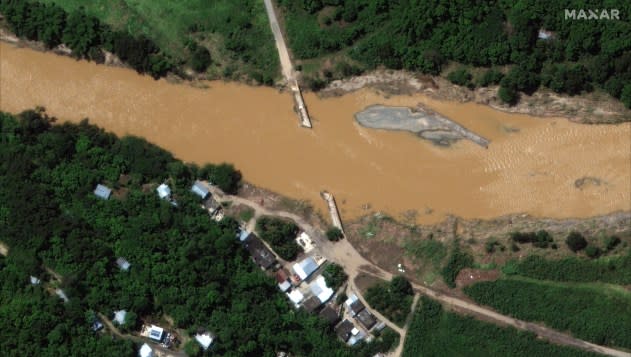When it comes to retired hurricane names, one letter stands out
As meteorologists track Idalia, which is expected to strengthen into a formidable and dangerous hurricane before bearing down on Florida, they have noted that some of the most notorious tropical storms in history have begun with the letter "I." Just in recent years, Ian, Ida and Irma all wreaked havoc and left behind death and destruction in the United States.
Since 1954, 96 tropical storm names have been retired in the Atlantic, which occurs when storms reach a certain threshold and are considered too deadly and costly to remain on the hurricane season naming list. Fourteen storms beginning with the letter "I" (including Iota 2020, a name which is technically a letter of the Greek alphabet) have been retired. That accounts for a significant number compared to the runner-up, "F," which has only 10 retired storms.
The storm names are eventually replaced if the storm becomes deadly or costly enough "that the future use of its name on a different storm would be inappropriate for obvious reasons of sensitivity," according to the National Hurricane Center (NHC).
Why have more storms starting with the letter "I" been retired than any other letter? It's mostly a coincidence since retirement doesn't have hard and fast rules, relying instead on human interpretation of a storm's effect on people.
 |
"This is mostly just luck, because if it was related to the time of year, then 'H' and 'J' storms should be pretty high too (or 'G' and 'K' for that matter), and they're not," Brian McNoldy, a senior research associate at the University of Miami's Rosenstiel School of Marine, Atmospheric, and Earth Science, wrote in his blog. He also pointed out that seven of the "I" storms have been retired in the last 14 years.
Have the app? Unlock AccuWeather Alerts™ with Premium+
Storms starting with both "F" and "I" were retired in 2022 -- Fiona and Ian. The storm names were retired due to "the death and destruction they caused in Central America, the Caribbean, the United States, and Canada," the World Meteorological Organization (WMO) stated.
Hurricane Fiona heavily impacted several countries. It first made landfall on Sept. 18, 2022, on the extreme southwestern coast of the U.S. territory of Puerto Rico as a Category 1 hurricane with maximum sustained winds of 85 mph.
The hurricane caused a territory-wide blackout in Puerto Rico, along with destructive flooding. About 12 hours later, Fiona made landfall in the Dominican Republic with sustained winds of 90 mph. Eventually reaching Category 4 status over the Atlantic, Fiona chugged through the Turks and Caicos as a Category 3 storm.
 |
Satellite images of a bridge in Arecibo, Puerto Rico, before and after Hurricane Fiona flooding. |
Fiona struck Atlantic Canada as a post-tropical cyclone, becoming the costliest extreme weather event in the region's history. In total, Fiona was responsible for 29 direct and indirect fatalities, along with over $3 billion in damages across the Caribbean and Canada.
Hurricane Ian made landfall on Sept. 27, 2022, on Cuba's Pinar del Rio province as a Category 3 hurricane. The hurricane then set its sights on the United States, making landfall as a Category 4 hurricane in Lee County, Florida, the next day.
The storm was responsible for 149 fatalities, making it the deadliest hurricane in Florida since 1935. Wind gusts reached well beyond 100 mph in some cases, including a gust of 128 mph in Grove City. Damages from Ian cost over $112 billion in the United States alone, becoming Florida's costliest hurricane in history.
 |
Bruce Hickey, 70, walks along the waterfront littered with debris, including shrimp boats, in the mobile home park where he and his wife Kathy have a winter home, a trailer originally purchased by Kathy's mother in 1979, on San Carlos Island, Fort Myers Beach, Fla., Wednesday, Oct. 5, 2022, one week after the passage of Hurricane Ian. (AP Photo/Rebecca Blackwell) |
Forecasters utilize six rotating lists of names to identify storms on an annual basis in the Atlantic and East Pacific and four lists in the Central Pacific. According to the WMO, storms are assigned names in part to help communicate storm warnings and raise awareness about the life-threatening risks they pose.
Hurricanes have been given various types of names dating back to the 1800s. But in 1953, a new international phonetic alphabet was introduced to name storms. According to the NHC, this was the year that the United States started using female names for storms. That process remained in place until 1978 when male names were added to the East Pacific storm names list. In 1979, a rotating list of male and female names was used in the Atlantic.
Want next-level safety, ad-free? Unlock advanced, hyperlocal severe weather alerts when you subscribe to Premium+ on the AccuWeather app. AccuWeather Alerts™are prompted by our expert meteorologists who monitor and analyze dangerous weather risks 24/7 to keep you and your family safer.





